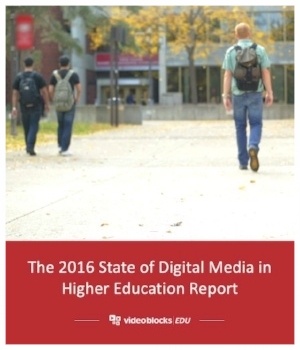
Last week we began our two-week feature on frustrations with digital media surfaced by our educational survey, the State of Digital Media in Higher Education Report. The report focused on gaining insight into how campuses are implementing digital technologies and what barriers, if any, prevented them from doing so. As we noted last week, our findings revealed two common trends and frustrations, voiced by both educators and students alike. The first was a common consensus among respondents that improving classroom technologies and resources were still too difficult to locate and use. This week we’ll be focusing on the second trend our survey highlighted: the problems many educators encounter when trying to successfully learn about and implement digital technologies in the classroom.
In our survey, many educators responded with sadness and resigned frustration that there was “a great difficulty in keeping up with innovations,” in large part due to a lack of direct support from their institutions. This seemed to be at the crux of many educators’ struggle to update their syllabi and coursework around new and emerging digital curriculums. Despite a strong desire to learn about and be trained in new technologies, most campuses offered only limited teacher training in these vital tools, if they offered them at all.
A majority of educators cited a “lack of consistent technical support from the university” or a “lack of training, both on the instructional and student levels” as one of the most significant barriers to digital education in their classrooms. While a number of campuses do offer some basic or remedial training in newer technologies, teachers and staff often find them impractical and inaccessible, either due to scheduling and availability or due to the low quality of the sessions.
“Trainings are also almost never available online,” noted one teacher, “but are given face to face when no one can attend them. They are of an extremely poor quality, and created by those who have no teaching ability.” Similarly, another professor wrote, “we are required to attend many, many hours of training. It's all there on YouTube. Not sure why we have to jump through hoops.”
At the core of the issue, educators face the difficult question of whether or not digital literacy or proficiency in new technologies is a priority for their campuses. While many institutions do have varying mandates for digital curriculums or specialized programs, the lack of quality technological support across all departments and fields—not just for the innovations labs or specialized media programs—belies the fact that universal, campus-wide digital literacy is often not a priority. If it is, as some educators pointed out, then the time and training resources required to bridge the literacy gap must be put forward by the teachers and students themselves, without the support of their administrations.
The time investment involved in learning new technologies proficiently, particularly with an eye towards classroom implementation or student training, cannot be overstated. Many teachers and staff find themselves in the difficult bind of having received digital learning mandates from their program or school leaders, but without any clear roadmap as to how they are to first train in these new tools themselves.
Left to self-teach on their own time, or by attending online classes and weekend workshops, teachers and staff are often dismayed at the additional time expenditures needed, especially when put in the contexts of their already overtaxed workloads. “It is difficult enough staying current in my rapidly changing field when teaching three 4-credit hour classes a semester,” one educator wrote us. “I know that there are digital resources available that could help with student learning, but I don't have time to research and figure out how to use these tools on my own.”
“There is just no time,” one particularly frustrated teacher put it, for learning the necessary new technologies that students and our fast-paced, technologically-mediated world require of our educators. As a result, these needed technologies and digital resources never make it to the classroom.
This deficiency in training and implementation is not only felt by the educators directly involved but also by their students, who are often confused by the discrepancies between their hypermediated extracurricular lives and their low-tech classroom realities. Sadly, many students are quick to blame their instructors for not introducing or adopting technology in the classroom, rather than a lack of available resources or proper training.
“Digital media is growing and more teachers should be more accepting when it comes to it,” wrote one student in our survey, while another noted that classrooms were often dominated by “high use of outdated digital media.” Because students often only see one side of the struggle to implement digital resources, it is easy for them to place the blame at the feet of educators. “My teachers just don't know how to use technology,” one student pithily summed up the matter.
What most of these students don’t understand, and cannot understand since they aren’t privy to the internal workings of academic programs and campus politics, is that most educators are for increased digital literacy and technology use in the classroom. Yet, as we’ve seen in both this week’s post and last’s, they often feel that their hands are tied due to a lack of available resources or proper training.
How can universities start making digital literacy and new technologies more of a priority? One solution is our new U-Curate platform, in conjunction with our Digital Backpack. U-Curate is a centralized content management platform that allows faculty, students, and campus media designers to quickly and easily discover and download university-created footage.
At its heart, we designed the platform to help universities more fully realize the potential and impact of their digital resources and assets, while also providing ease of use and access. Too often campuses lack the digital architecture to connect the dots between their already existent media assets and the offices, classrooms, and labs that would most benefit from that content. U-Curate answers this problem by surfacing and distributing university creative media through the platform’s powerful content organization system.
To learn more about student and educator frustrations with implementing new technologies in the classroom, download our 2016 State of Digital Media in Higher Education Report.


